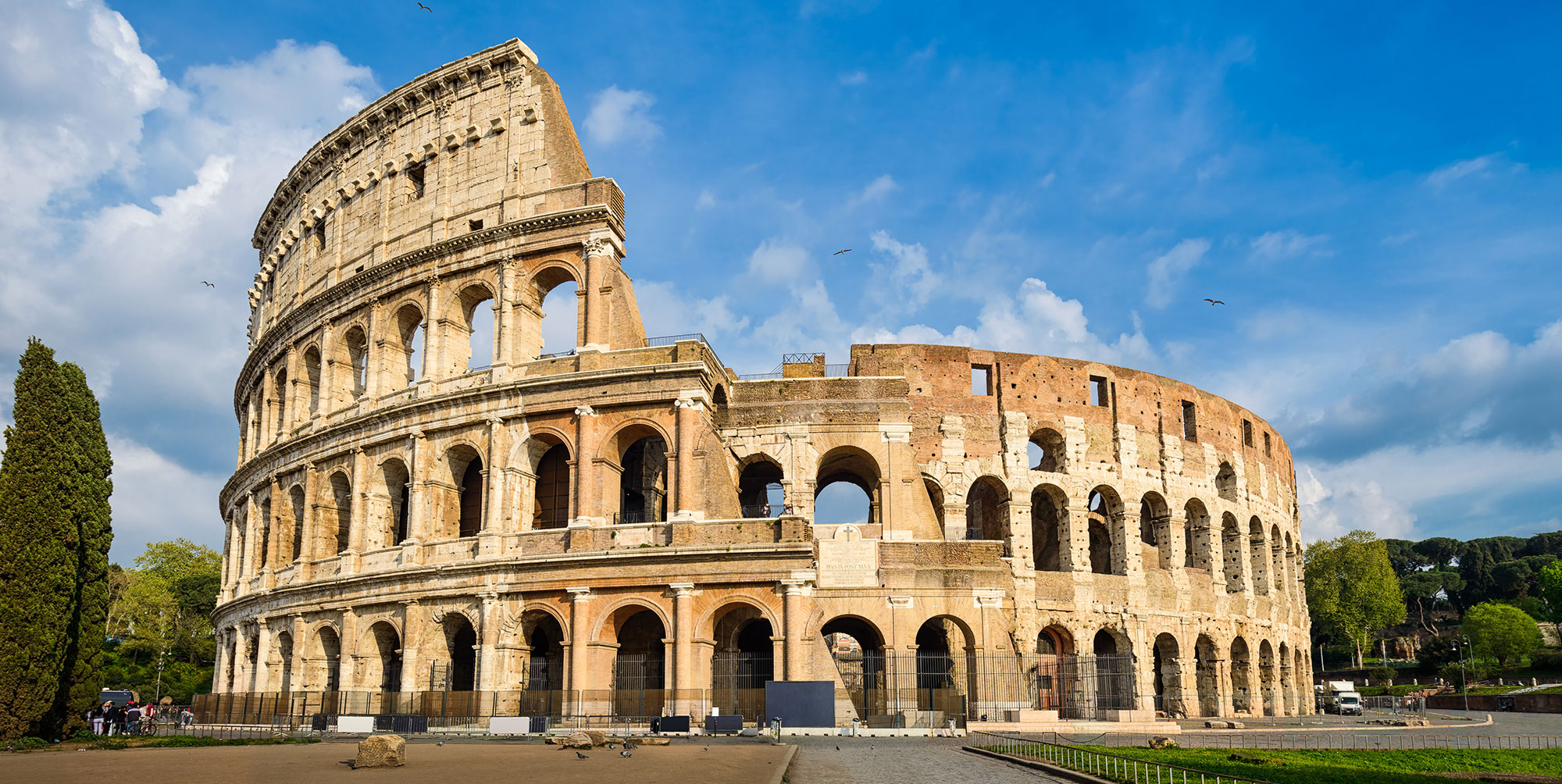Many popular ideas about the Roman arena were formed in the nineteenth century from popular images and accounts. The influential artist Jean Léon Gérôme used genuine gladiatorial art and equipment from Pompeii as models for his paintings of ancient Rome and the arena, but he also invented freely in dramatizing his scenes. Movies from Quo Vadis to Gladiator have drawn on such works to depict a world of strangely armed gladiators, Christians nobly awaiting attack by lions, and "thumbs down" death-gestures by emperors and rabid crowds. Actual Roman images of the arena are quite different: crowds and emperors are rarely shown, we are not sure which direction the thumb actually pointed in the famous death gesture, and victims of attack by big cats were certainly neither dignified nor noble.
The Romans glorified the bravery shown in the arena, but trivialized the events and degraded the participants. Mosaic pictures of executions and combats, graphically violent to our eyes, were displayed in the public rooms and even dining rooms in the homes of wealthy Romans. How can the viewer today possibly understand such images? Until fairly recently, modern authors writing about the arena minimized its significance and represented the institutionalized violence as a sideline to Roman history. The tendency was also to view the events through our own eyes and to see them as pitiful or horrifying, although to most Romans empathy with victims of the arena was inconceivable. In the past few decades, however, scholars have started to analyze the complex motivations for deadly public entertainments and for contradictory views of gladiators as despised, yet beloved hero-slaves.

Protests by Romans against the games were rare (Seneca, Letters 7.2-5), and complaints (at least by non-Christians) tended to focus on the low aspect of the entertainment rather than on the cruelty of the events. Far from being pitiful or horrifying, the image of an adult being thrown to the beasts was a reminder of an edifying entertainment. Roman scenes in different media show bloody attacks by lions and leopards against men propped up in the arms of animal-handlers, or tied to stakes in moveable carts. The image might have made a new, foreign slave wince as he cleaned the mosaic floor, and it might have caused him to think twice about running away. Nevertheless, it was clearly not intended to make those household slaves whose roles were well-established feel uncomfortably empathetic. Rather, it documented the brutal maintenance of social order and reinforced the solidarity of those who already belonged to that order.
The Context of the Games

The arena played a significant role in Roman public life from the third century B.C. into the fifth century A.D., but the origin of gladiatorial games is somewhat obscure. The earliest recorded Roman examples were hand-to-hand combats, probably involving captives, performed at funerary games at Rome. The first took place in in the Forum Boarium (the cattle market) in 264 B.C. The two sons of Brutus Pera gave an exhibition of an unspecified number of gladiators in honor of their dead father (Valerius Maximus 2.4.7). The three sons of Marcus Aemilius Lepidus presented funeral games for three days in their father's honor in the Forum Romanum in 216 B.C., providing 22 pairs of gladiators (Livy 23.30.15). From these relatively modest beginnings the games grew and grew.
The arena played a significant role in Roman public life from the third century B.C. into the fifth century A.D., but the direct origin of gladiatorial games is somewhat obscure. The Etruscans are credited (secondhand, by the Greek writer Athenaeus in the first century A.D., who was quoting an earlier, lost source) as the originators of the games, but Etruscan art does not depict any clear gladiatorial combat. Campanian tomb paintings from the area of Paestum do show combat by pairs of men in the fourth century B.C. The earliest recorded Roman examples were hand-to-hand combats, probably involving captives, performed at funerary games at Rome. The first took place in the Forum Boarium (the cattle market) in 264 B.C. The two sons of Brutus Pera gave an exhibition of an unspecified number of gladiators in honor of their dead father (Valerius Maximus 2.4.7). The three sons of Marcus Aemilius Lepidus presented funeral games for three days in their father's honor in the Forum Romanum in 216 B.C., providing twenty-two pairs of gladiators (Livy 23.30.15). From these relatively modest beginnings the games grew and grew.
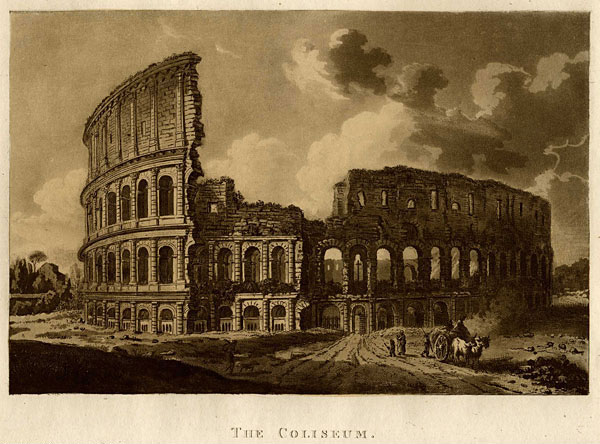
By the late Republic the full political potential of gladiatorial and other shows was increasingly exploited. A show, munus, was paid for by a munerarius or editor to fulfill his civic and religious duties and illustrate his wealth and social or political status. Games were no longer produced just for funerals and memorials, but also for birthdays, dedications, inaugurations, victories, and other occasions. Munerarii expended vast sums on exhibitions pitting men and beasts against one another in various combinations. In the mid-sixties B.C., Julius Caesar (the future dictator) made himself extremely popular by giving lavish public theatrical performances, banquets, parades, and a show including 320 gladiators (Plutarch, Caesar 5).
On numerous occasions the senate passed decrees restricting who could give gladiatorial games and regulating both an editor's expenses and the numbers of gladiators he could exhibit. By the first century A.D., giving games was made a requirement of certain public offices, which helped guarantee the presentation of shows on a regular basis. Costs for games not organized by an emperor were limited, and gladiatorial schools came under Imperial control. These regulations kept munerarii from bankrupting themselves. More important, wealthy individuals were prevented from building up armies of gladiators or making themselves too popular by hosting extravagant shows. Gladiatorial and other games of the arena became state-sponsored events, presided over whenever possible by the emperor. The scope of some of the games was staggering; Titus's games in A.D. 80, at the inauguration of the Colosseum, and Trajan's in A.D. 108 went on literally for months and involved many thousands of animals and men (Dio Cassius 66.25, 68.15).
The presentation of games and beast-fights spread throughout the empire. New cities included amphitheaters among their public buildings, while older cities added them or made do with existing structures or temporary wooden ones. Audiences represented all members of society, and artists and craftsmen created images of the arena suitable for all social classes. Mosaics, gemstones, ivories, and metal objects were intended for the wealthy, who sometimes also commissioned art to show events they had paid for or especially enjoyed. Mass-produced items such as vessels, lamps, and figurines of clay and bronze were aimed at a wider, poorer audience and served as souvenirs and mementos of executions, beast-fighting, and gladiatorial combats.
Arenas and Other Facilities
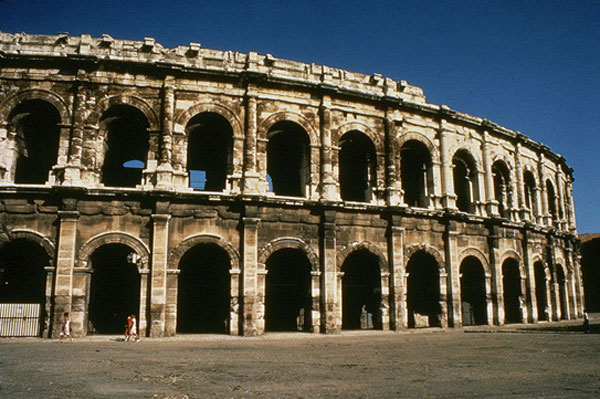
The term arena, signifying the place of combat, is derived from arena or harena, the sand sprinkled on the fighting field to soak up blood and facilitate cleaning. Spectacula, from which our word "spectacle" comes, can signify the seats as well as the events viewed in an arena. Although the amphitheater was developed as the special space for gladiatorial events, it was not the first or only site for them. Fora (public squares) and circuses (venues for chariot-racing) were used first. A theater and stadium could also served, in the absence of an amphitheater or circus, as a site for arena games, especially in Greece and the east. (The words "theater" and "stadium" in Greek and Latin could also signify "amphitheater.") In a pinch, any open space might do.
The rectangular open area of a Republican forum was considered an especially suitable space for combats. According to Vitruvius, a Roman architect of the first century B.C., the Romans could not lay out their fora the way the Greeks did, since the practice of holding gladiatorial games there had been handed down from the Romans' ancestors (de Architectura 5.1). Vitruvius recommended forum proportions of 3:2 length to width (de Architectura 5.1.2). To transform a forum into an arena, the giver of the games would construct wooden seats on the upper floors and balconies of the surrounding buildings and erect barriers at the entry points on ground level (Cicero, pro Sestio 124-26, Plutarch, Life of Gracchus 12.3). Thus, the viewers were raised above the fray and the exits for combatants were closed, as was later the case in amphitheaters. In the Roman Forum, many thousands of spectators were packed into the seats, which extended up the Capitoline Hill.
Beast-hunts were often presented in circuses (or in stadia and hippodromes in the Greek world) until the seventh century A.D. Cages for wild animals were possibly added to the Circus Maximus in Rome in 174 B.C. (Livy 41.27.6). The seating area around the long, open field of a small circus or stadium was not necessarily larger than that around the open area of a forum. A larger circus, however, could seat as many as 100,000 viewers (the Circus Maximus in Rome may have held as many as 250,000), making it impossible for spectators at one end to see anything clearly at the other. The central spine or barrier (spina) around which chariots raced also impeded lines of sight. In circuses, organizers spaced combatants and animal hunts throughout the field so that everyone would have something to watch.
As amphitheaters became increasingly common in the first century B.C., fora went out of favor as places for holding games. The symmetrical shape of the permanent facility made it easier to see, and munerarii did not have to pay for the construction of seats. The word "amphitheater" (a theater on both sides) is first attested in the late first century B.C. by Vitruvius (de Architectura I.7.1). The first amphitheater in Rome (in 52 B.C.) was Gaius Curio's wooden model, formed by rotating and joining two theaters built back-to-back so that they formed an oval (Pliny, Natural History 36.113-120). Statilius Taurus constructed a stone amphitheater in 29 B.C., destroyed in Nero's famous fire of A.D. 64 (Dio 51.23). The Colosseum, although famous as the symbol of gladiatorial combat in Rome, was not inaugurated by Titus until A.D. 80. It was unusually large, perhaps seating over 50,000 viewers. Some of the best-preserved amphitheaters survive today in France (Arles, Nimes), Italy (Pompeii, Rome) and Tunisia (El Djem).
The Arena: Shows in the Morning
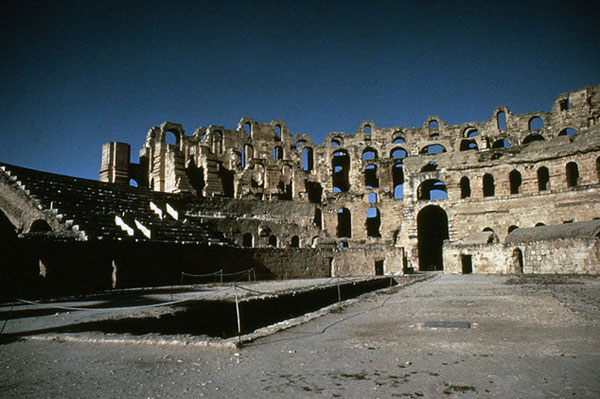
When a munerarius could afford it, he tantalized the crowd with shows exotic and large in scale as well as violent and bloody. There were, of course, vast differences in the numbers and scale of entertainments offered at Rome or other large urban centers and those provided in smaller towns. While the games in small towns were relatively expensive productions, nothing could match the shows put on in Rome by an emperor. The populace was regularly treated to a variety of entertainments, and Romans became blasé. In the first century B.C., Cicero, who thought there was nothing especially appealing about watching a human being mangled by a more powerful animal, was not horrified by the idea, but bored of it. Even if it was supposed to be exciting, he said, there was nothing new in it (Letters to Friends 7.1.3).
The mainstay of the games was violent combat between various combinations of animals and people. Animals included the mundane and tame as well as the exotic and ferocious. The majority of human participants were male, although women were sometimes punished in the arena or even (rarely) served as gladiators. Events may be crudely subdivided into three categories. First, in venatio (plural venationes), trained hunters (venatores) killed dangerous animals with spears in a display reminiscent of the animal hunts of Roman aristocrats. In a munus lasting a day or longer, a venatio might serve as the morning's entertainment. Carnivores were also set upon one another or incited to attack weaker animals, and men less skilled than venatores fought dangerous beasts or massacred tame ones in various ways. The crowd expected to see animals killed rather than merely displayed. Depictions in art reveal that the Romans enjoyed watching both the inevitable subjugation of weaker by stronger and also the combat of different, but equally dangerous, opponents (such as a bear and a bull). Although munerarii expended enormous amounts of money to obtain animals, ship them, and keep them healthy for a show, in the end it was often probably cheaper to kill them than to house, feed, and doctor exotic animals to maintain them for later use.
Second, the arena served as a place of dramatic public execution in the form of such tortures as crux (crucifixion), crematio or vivicomburium (burning alive), or damnatio ad bestias (throwing people to the beasts). These executions sometimes took place during the noon break, when some members of the audience might leave for a meal and a nap. A painted announcement of an upcoming show, preserved at the entrance to tombs of the Via delle Tombe at Puteoli, describes the highlights of games to be held at Cumae, including 20 pairs of gladiators, crucifixions, and a venatio, and the announcement stresses that an awning will be provided for the spectators. Since viewers sat all day in the hot sun, an awning was a significant attraction.
The people executed publicly were usually criminals, prisoners of war, deserters from the army, and other troublemakers and outcasts (such as slaves who had run away, or Christians who would not offer a sacrifice to the gods of the state or to the emperor). At least in theory, such damnati opposed social or military order and deserved their harsh fate. They were treated as no better than animals, and are illustrated in art in conjunction with animal-fights and the slaughter of prey animals, a distinction the Romans made, which could include everything from ostriches to deer. Even so, wanton cruelty by an official did not go unnoticed. Tacitus comments on the negative reaction when Nero (A.D. 54–68) punished Christians seemingly out of cruelty rather than for the public good (Tacitus, Annals 15.44). Caligula (A.D. 37–41) was known for forcing anyone he did not like into the ring, including spectators who annoyed him (Dio Cassius 59.10, 13-14). This subversion of the proper relationship of munerarius and audience and spectator and spectacle was especially offensive.
The story of Androclus and the lion documents several aspects of execution by damnatio ad bestias: the crime, communication by placard, and the viewers' influence on the outcome of a show. It also illustrates the crowd's love of the unusual. Androclus was the runaway slave of a proconsul in Africa during the time of the emperor Caligula. He was caught after his master had completed his official duties and returned to Rome, and so Androclus was sent to Rome as well and ended up being thrown to the beasts in the Circus Maximus. When a lion sent to attack Androclus instead licked him, the crowd's interest was piqued, and Caligula questioned the slave. Androclus explained that he had hidden in the lion's den in Africa, where he had removed a splinter from its foot. Coincidentally, the lion and the slave had both been captured at about the same time and sent to Rome. Androclus's story was summarized on a placard (probably on several) and carried around the circus. The crowd requested (by yells or chants) that Caligula set Androclus free and present him with the lion, and Caligula obliged (Aulus Gellius, Attic Nights 5.14).
The Arena: Shows in the Afternoon
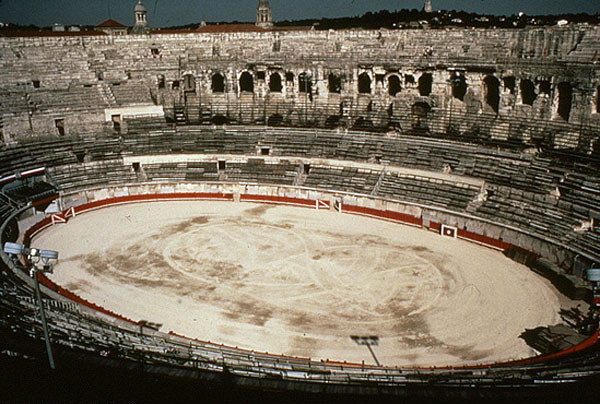
The third and most prestigious category of events in the arena, saved for the afternoon, was gladiatorial combat. Most gladiators were prisoners or slaves compelled to fight, but some also enlisted voluntarily as free or freed men. Gladiators took an oath to hand themselves over to their master, body and soul, and to submit to being beaten, burned, or put to the sword (Horace, Satires 2.7.58-59; Petronius, Satyricon 117; Juvenal 11.5-8), so even volunteer gladiators became property. Although gladiators as a group were despised for their low status and occupation, individual fighters could become famous and even rich. Untrained men were sometimes sent out to die, but gladiators, like soldiers, were trained to use specialized defensive and offensive weaponry and to survive as long as possible.
Straightforward combat between similarly armed warriors was a major component of gladiatorial games. The Roman interest in watching the conflict of different but equal opponents, however, seen so clearly in depictions of beast-fighting, is also reflected in human combat. The most famous confrontation of fighters using different styles (immortalized in the movie Spartacus) involved a retiarius, a semi-nude fighter armed with a long trident and a net, and a heavily armed warrior protected by body armor and carrying a shield and sword. The retiarius could keep his less mobile opponent at a distance with the trident and immobilize him with the net, but was in grave danger during close combat.
Gladiatorial duels provided the crowd with a direct opportunity to participate in life-and-death decisions. A gladiator who knew he was about to lose his duel would ask the munerarius to pass judgment on him and grant him missio—allow him to be "sent away" (missus) alive. A fighter who was still standing would raise his finger in the air, while one who was down would raise his arm or make some other gesture to signal defeat. A munerarius was expected to turn the matter over to the crowd, which expressed its verdict by yelling or by making the famous gesture generally assumed to be "thumbs down." The art depicting gladiatorial combat illustrates that referees intervened between the fighters while the munerarius decided what to do. A gladiator who fought well enough to win his duels (or to lose but earn missio) was a good investment, since he knew how to please an audience and survived to fight another day. Under the system of missio, the time and money invested in training gladiators was not wasted after only one combat.
The audience demanded courage and respected a good combatant, whatever his social standing. An exhibition of skill or bravery was supposed to be uplifting (Pliny, Panegyric 33), and a gladiator who was not granted missio was expected to kneel with dignity to accept the death-blow. If he pleased the crowd and survived long enough, he could eventually win his freedom. Many gladiators whose chances for a decent life outside the arena were small, or who did not want to abandon excitement and fame, actually reenlisted when they had served their time. A parallel, although a less deadly one, can be drawn with boxing and now "ultimate fighting" to which retired fighters sometimes return. The numerous funerary monuments erected by family members for gladiators who died in the arena indicate that, in the long run, a voluntary gamble with one's life did not pay. Surviving even ten combats was rare.
Social Hierarchy and Public Punishment
The Roman arena functioned on one level as a display of the social order, from the slaves and the dispossessed in the ring to the powerful provider of the games at the top of the hierarchy. The illustration of social status in the stands at public shows of all kinds was an important aspect of public entertainment. Tacitus (Annals 13.54) uses the term discrimina ordinum (the separation of the orders) to describe the segregation of senators, equites "knights;" members of the Roman middle class who originally served in the cavalry), and plebes (the Roman lower classes) in the theater. Although seating in the circus and amphitheater may have been more lax than in the theater, there was clearly a hierarchy of arena seating according to social rank. The best seats were those closest to the sand, where emperors and presiding officials had special boxes. In an era without news media, games and other public entertainments served as occasions for the exchange of information between different levels of society. As in the story of Androclus, the emperor or responsible official addressed the crowd by means of heralds and placards, and the crowd expressed itself with yells, chants, and gestures, or with unresponsive silence.

The emphasis on relative social position made it especially inappropriate, and therefore thrilling for a member of the upper orders to appear in the arena. The senate repeatedly passed laws against the participation of senators or equites as gladiators, since some men (and even some women) were willing to disgrace themselves by fighting for the sake of money or excitement. Although we have no specific evidence about special treatment for higher-class participants, it is hard to believe they would have entered the arena if the same harsh rules applied to them as to the lower orders and slaves. The Romans punished the social classes quite differently, so a member of an upper order could not be condemned to the games. A senator might be exiled and an eques conceivably paraded or flogged as a public humiliation (Scriptores Historiae Augustae, Hadrian 18.9), but he would not face condemnation to the beasts, to the gladiatorial games, or to other degrading, physically dangerous penalties.
We are today particularly struck by the fact that the Romans institutionalized killing as public entertainment. Although a munerarius certainly wanted his show to entertain the audience, the penal aspect of the games and events in the arena was crucial. The Romans saw harsh public discipline, at least for the lower orders, as an appropriate form of retribution and an effective deterrent to wrongdoing. The arena was only one place of public punishment; criminals were also crucified along roads and at crossroads. Both the widespread belief in the inferiority of those lower down the social scale, and also the longstanding idea that criminals deserved to feel pain, facilitated the crowd's ability to distance itself from those in the ring and watch their deaths with excitement and pleasure. The art depicting combats and executions takes for granted an emotional distance between viewer and viewed. Many other societies have also made punishment a form of public show at which watchers are both entertained and warned about the results of antisocial behavior. Public hangings are an example from our own history. Nor is it unusual for upper classes or the socially and politically more powerful to be punished differently from lower classes.
The Romans are unusual, however, in transforming public killing into entertainment to this degree and in allowing an audience to affect the outcome of gladiatorial duels. The Romans' emphasis on martial values and courage, their class structure, their belief in slavery, and their love of public shows all merged in the creation of a unique institution that functioned on many levels. The state encouraged, rather than merely sanctioned or oversaw, the public killing of criminals in an atmosphere of sometimes carnival revelry. Roman militarism and familiarity with war, society's desire for scapegoats, a need for mass release of tension, the cathartic public confrontation of death, and many other explanations have been given for the Roman love of the arena. A single reason is unlikely; the relationship of spectator and spectacle was a complex social construct rather than a simple symbol of pagan violence.
To learn more about Latin terms for gladiatorial weapons and the lingo used during combat, go to "The Language of the Arena."


